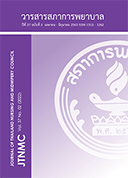Advanced Guidelines for Resuscitation Practice for Patients with Cardiac Arrest after Open-Heart Surgery: Roles of Nurses
Keywords:
advance guidelines, open heart surgery, cardiac arrest, roles of nurseAbstract
Cardiac arrest after open-heart surgery is a complication more commonly found than cardiac arrest in any other situations. This is because open-heart surgery requires the use of a heart-lung machine as a functional replacement of the heart during the operation. The process of using the heart-lung machine can contribute to the patient’s electrolyte imbalance, abnormal coagulopathy, active bleeding after cardiac surgery, and cardiac tamponade, all of which can cause cardiac arrest. On the other hand, prompt treatment can lead to positive prognosis of a cardiac arrest event. The ‘Advanced Guidelines for Resuscitation Practice for Patients with Cardiac Arrest after Open-heart Surgery’ can lead to shorter time spent on saving lives and reduce complications. The main objectives of this article are to present a review of literature pertaining to open-heart surgery, to propose the ‘Advanced Guidelines for Resuscitation Practice
for Patients with Cardiac Arrest after Open-heart Surgery’, and to discuss the roles of nurses in resuscitating open-heart surgery patients in pre-, peri-, and post-cardiac-arrest stages following an open-heart surgery situation. Critical care nurses play an important part in the assessment of risk and the prevention of reversible causes of cardiac arrest from the stage before the cardiac arrest. As members of a caregiving team, nurses assist the patients during a cardiac arrest event, according to their assigned roles. Other roles of nurses include coordination, medical equipment management, monitoring of the patient’s post-resuscitation circulatory system to shorten resuscitation time, minimising resuscitation-related complications, and maximising the patient’s chance of survival.
Downloads
References
The Society of Thoracic Surgeous of Thailand [Internet]. Bangkok:stats; 2019 [cited 2021 Oct17]; Available from https://thaists.org/en/stats/
Nolan JP, Soar J, Smith GB, Gwinnutt C, Parrott F, Power S, et al. Incidence and outcome of in-hospital cardiac arrest in the United Kingdom National Cardiac Arrest Audit. Resuscitation. 2014;85(8):987–92.
Michaelis P, Leone RJ. Cardiac arrest after cardiac surgery: an evidence-based resuscitation protocol. Crit Care Nurse. 2019;39(1):15–25
Society of ThoracicSurgeons Task Force on Resuscitation After Cardiac Surgery. The Society of Thoracic Surgeons Expert consensus for the resuscitation of patients who arrest after cardiac surgery. Ann Thorac Surg. 2017;103(3):1005–20.
ChoudhariMS,SonkusaleMI,DeshpandeRA.Sudden cardiac arrest on 5th day after coronary artery by pass graft surgery:diagnosticdilemma.AnnCardAnaesth. 2018 ;21(3):341–2.
Dunning J, Levine A, Ley J, Strang T, Lizotte D, Lamarche Y, et al. The society of thoracic surgeons expert consensus for the resuscitation of patients who arrest after cardiac surgery. Ann Thorac Surg. 2017;103:1005-20
Sarkar M, Prabhu V. Basics of cardiopulmonary by pass. Indian J Anaesth. 2017;61(9):760–7
Peretto G, Durante A, Rosario L, Cianflone D. Postoperative arrhythmias after cardiac surgery: incidence, risk factors, and therapeutic management. Cardiol Res Pract. 2014; 2014:1-15
Brand J, McDonald A, Dunning J. Management of cardia carrest following cardiac surgery.BJAEducation. 2018;18(1):16–22
Gocot R, Hungziak D, Bis J, Mendrala K, Morkisz L, Podsiadlo P, et al. The role of deep hypothemia in cardiac surgery. Int J Environ Res Public Health. 2021;18(13):7061.
Ley SJ. How should we manage arrest following cardiac surgery? Semin Cardiothorac Vasc Anesth. 2015;19(2):87-94.
Kudenchuk PJ, Brown SP, Daya M, Rea T, Nichol G, Morrison LJ, et al. Amiodarone, Lidocaine, or placebo in out-of-hospital cardiac arrest. N Engl J Med. 2016;374(18):1711–22.
Twomey D, Das M, Subramanian H, Dunning J. Is internal massage superior to external massage for patients suffering a cardiac arrest after cardiac surgery? Interact Cardiovasc Thorac Surg. 2008;7:151-6.
Resuscitation Guidelines 2015.Resuscitation Council UK.Availablefrom:www.resus.org.uk/resus citation guidelines
Colson PH, Gaudard P, Fellahi J-L, Bertet H, Faucanie M,AmourJ,etal.Active bleeding after cardiac surgery: a prospective observational multicenter study. PLOS ONE. 2016;11(9):e0162396.
Jacobs IG, Finn JC, Jelinek GA, Oxer HF, Thompson PL. Effect of adrenaline on survival in out-of-hospital cardiac arrest: a randomised double-blind placebocontrolledtrial.Resuscitation.2011;82(9):1138–43.
Patanwala AE, Slack MK, Martin JR, Basken RL, Nolan PE. Effect of epinephrine on survival after cardiac arrest: a systematic review and meta-analysis. Minerva Anestesiol. 2014;80(7):831–43.
Peberdy MA, Callaway CW, Neumar RW, Geocadin RG, Zimmerman JL, Donnino M, et al. Part 9: post–cardiac arrest care. Circulation. 2010;122 (18_suppl_3):S768–86.
Pellis T, Sanflippo F, Ristagno G. The optimal hemodynamics management of post-cardiac arrest shock. Best Pract Res Clin Anaesthesiol. 2015; 29(4):485-95.
Downloads
Published
How to Cite
Issue
Section
License
Copyright (c) 2022 Thai Journal of Nursing Council

This work is licensed under a Creative Commons Attribution-NonCommercial-NoDerivatives 4.0 International License.








